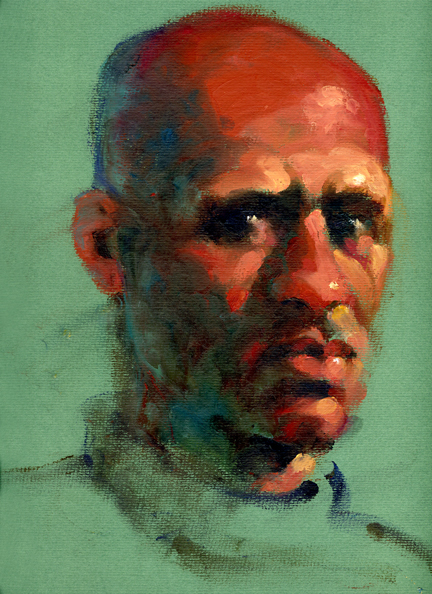The Truth About Brushes
What to look for when purchasing a brush for oils or acrylics.
The truth is, most artist brushes are mass produced in the same manufacturing plants to keep the costs down. Until the Industrial Revolution was in full swing and the trade of new materials were available, the Old Masters painted strictly with round brushes handmade by themselves or their apprentices using local materials. Now mass production enables some Companies to have their branded handle put in the same ferrule as their competitors. The country of origin can be found either on the handle itself or on the barcoded sticker usually found at the bottom of the handle. A lot of brushes are mass produced in the Dominican Republic or Sri Lanka. The three examples below are examples of excellent quality synthetic brushes and the brush made in spain, was entirely made by hand, in-house.

At the moment there is no International Standard for artist's brushes. This is why you'll find that a number 4 in one brand may look like a number 8 in another. Another drawback to not having a "standardization" means that any manufacturer is allowed to say their product is of "artist quality". They can also be ambiguous as to the quality of the hair in the brush. Brush hair and synthetic filaments vary greatly in grades and price. Natural hair should be flagged at the tip, which means each hair should have a 'split-end'. Expensive natural hair brushes should never be cut at the tip; the trimming should all be done at the root. Quite often there will be more hair beneath the ferrule than on the outside. The two brushes below are examples of the best you can buy. The bristles and filaments are of the best quality. They are secure. The handles are protected and the ferrules are tightly crimped.

There is currently a shortage of quality natural hair, hence the hefty price for many quality brushes. This is also why you'll never find a fine quality brush at a 2$ Shop. The cheap brushes are usually cut along the top of the bristle and they lose their flagged tip. Good quality Artist's brushes also have brass or copper ferrules that are nickel or gold plated. These ferrules are finely crimped and do not have a seam. Good handles should be made from hardwood and be well lacquered with several coats.
An example of a lower cost brush that has inferior qualities is this one below. Not only does it not have any paint or lacquer to protect the handle from swelling, it is poorly crimped so the water will easily crawl up the ferrule reaching the filament, causing it to fall out.

All brushes used for acrylic and oils eventually wear down and have to be replaced. The amount of time a brush lasts depends a lot on how vigorously you paint or how diligent you are with the cleaning. Don't throw away your warn out brushes though because often they can be used for scumbling; even the inexpensive Chinese brushes, which we call "suicide brushes" are useful for some techniques. Acrylic paint is brutal on all brushes, but your brushes will last longer if you wet the brush first before loading it. Never clean your oil brushes with linseed oil as this is a drying oil and will eventually clog the ferrule. Never let your acrylic paint get so deep into the ferrule that it can't be removed. Both will dry and spread the hairs on the brush leaving a gap right in the middle of the hair or filament.
Below is an example of a brush that has dried acrylic down in the ferrule.

The brush below is a another good example of what will happen. A customer brought this brush into our shop (purchased somewhere else!) to ask, why it started to lose the bristles. Notice the glue at the end of the bristles and how little glue there really is to keep the bristles in tact. Once the un-lacquered handle came in contact with water, the brush was history.


The two examples of brushes down below are similar in style and priced comparatively. The brush on the left however, has a highly lacquered handle and although you can't see from the outside, the hair runs half-way down the ferrule with a greater amount of glue. Also notice the sizing difference...not much although one is a size 2 and the other a 14.

Both synthetic and bristle brushes can be used for painting with either oil or acrylic paints. However, I used the brush down below only 4 times to acrylic prime my boards for the workshop, each time cleaning it well when I finished. It didn't take long for the ferrule to start discoloring the handle and the bristles are already starting to fall out. This brush retails for just under $25.00. I would have been better off using a cheaper Chinese brush instead of paying for a brush made in Germany.

Remember that anything goes! (see blow) And, some of the most amazing paintings ever created were painted with sticks, feathers, fingers, make-shift brushes and now, on a computer tablet! And finally, be weary of those "demos" where retailers are brand specific. This is usually because they have a vested interest in certain brands. Ask other artist's what they use to get certain effects, read unbiased reviews and remember that every brush has a purpose.
For more information on Watercolour brushes (a whole other animal!), please see our tips and techniques page.
Just for fun we had our Stig paint with his fingers in our studio. He painted for about an hour and a half. Below are the results and what we think is a good example of the importance of form and color no matter what the tool. Here is what le Stig said:
"I haven't finger painted since I was very little. It was fun but my detail pinky has grown. I much prefer my brushes as it was harder to clean the paint under my nails than in my bristles."








How to buy
Note: we do not deliver outside New Zealand.
Enter the quantity and click "add to cart". When you are ready to pay for your order proceed to checkout. Payment is made by credit card on a secure server using Paypal or Payment Express. Alternatively you may pay by "bank deposit" or by phone on 09 489 7213.
Delivery Rates
Our delivery rates are:
- Prepaid A4 Satchel (nationwide): $5 per order †
- Local (Auckland): $5.50 per order *
- Local Towns (within 150kms): $7.50 per order *
- Rest of North Island: $9.30 per order *
- South Island and Great Barrier: $10.40 per order *
† Prepaid Satchel is available for some smaller items that will fit into an A4 envelope. Please do not select the satchel option if your goods are breakable, easily damaged or flammable.
* Oversized items may be charged an additional amount - once you have selected the items you need proceed to checkout to see the exact costs.
Rural delivery fee $3.30 per order
For privacy, returns and security policies please read our policies page.
About Takapuna Art Supplies
When we purchased Takapuna Art Supplies in April 2007 our intention was to make new friends and create an environment where professional and casual artists can purchase quality supplies and receive expert service and advice. Now, our most frequent comment from customers is, "what an artist's treasure-trove!" In February 2009 we added our tasart online store and we are now giving the same service, advice and selection to artists all over New Zealand. We stock over 17 thousand products and offer over 100 brand names and we continue to grow monthly with new product additions, tutorials and consumer information.
As fellow artists, we want every customer who walks into our shop or who shops on our online store, to be treated to a Smorgasbord of brand names from which they can choose. We are proud to say that we do not own the agency for any of the brands carried in our stores and, therefore, our customers can be confident that the product advice given by us is expert, sincerely informative and not tainted by conflicting profit guided prejudice. We purchase our supplies exclusively from reputable wholesalers and sell our stock at or below the manufacturer’s recommended resale price. Learn more about us...



